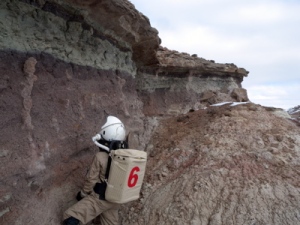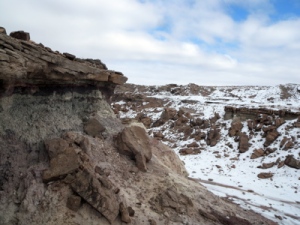With only a half-dozen EVAs under my belt, and going no further north than Olympus Mons in any of them, I was eager to get on either the biology or geology/geophysics teams for one of their extended EVAs. As crew astronomer, my contributions to the Hab are basically done: the radio telescope alterations have been completed, meaning that all I really need to do is sit next to the Radio Shack speaker while recording the signals on my computer. Not the most exciting use of the rest of my time on Mars, but I’m enjoying it (especially since I’m also learning Unix commands, which helps to pass the time). I’ve picked up some interesting noise during my recordings, but for the most part they are of terrestrial origins, particularly our radio squawks during our few completed EVAs since the finalization of the radio telescope alterations.
 Almost needless to say, I’ve been itching to get out and actually see the terrain surrounding the Hab. I’ve been up to the Mid-Ridge Planitia back on EVA 6, and yesterday I scaled Olympus Mons as part of EVA 14, but other than those my EVAs have been confined to the immediate Hab vicinity. So I jumped on the opportunity when LuÃs announced his plans to travel a few kilometers north to the area surrounding Lithe Canyon.
Almost needless to say, I’ve been itching to get out and actually see the terrain surrounding the Hab. I’ve been up to the Mid-Ridge Planitia back on EVA 6, and yesterday I scaled Olympus Mons as part of EVA 14, but other than those my EVAs have been confined to the immediate Hab vicinity. So I jumped on the opportunity when LuÃs announced his plans to travel a few kilometers north to the area surrounding Lithe Canyon.
I dressed and readied, eager to get back on the ATVs other than warming them up in the morning. The wind rushing under my helmet, the roar of the engine, the smooth gearshifts of Opportunity, everything just melded together in a sensory overload. The views were astounding, with cliffs and gullies and hills and rock formations streaming by as our twin exploratory rovers traversed the snow and mud-covered surface. We finally arrived at our destination after a few wrong turns, dismounted the pair of rovers, and trekked into the canyon.
 While I’m no geologist or biologist, even I could appreciate both the view of the rocks and the potential for diverse lifeforms within those rocks. I took a ton of pictures while LuÃs scouted the area for the best sampling site, always keeping an eye over my shoulder to check that we were still in visual range. While we couldn’t make it all the way to the canyon floor, since we would have no sure-fire way to scamper back out, but we did stumble across a face that had great geologic and biologic potential. This was also where LuÃs took out his patented EVA Bio Box to collect a handful of samples, and where I snapped quite a few photos in hopes that they’d be interpretable by Kiri upon returning to the Hab. Of course, I’d like to show my friends those pictures as well, since the scenery was quite stunning, so they eventually found their way onto my computer, but without the help of a cp…
While I’m no geologist or biologist, even I could appreciate both the view of the rocks and the potential for diverse lifeforms within those rocks. I took a ton of pictures while LuÃs scouted the area for the best sampling site, always keeping an eye over my shoulder to check that we were still in visual range. While we couldn’t make it all the way to the canyon floor, since we would have no sure-fire way to scamper back out, but we did stumble across a face that had great geologic and biologic potential. This was also where LuÃs took out his patented EVA Bio Box to collect a handful of samples, and where I snapped quite a few photos in hopes that they’d be interpretable by Kiri upon returning to the Hab. Of course, I’d like to show my friends those pictures as well, since the scenery was quite stunning, so they eventually found their way onto my computer, but without the help of a cp…
 With the sun sneaking out from behind the clouds during the sample collection process, our return journey was much slicker and dirtier than our path out. I took the lead, as LuÃs had encountered some radio problems, so that we could better keep track of each other’s locations for the drive back. We came down Lowell Highway, passing by Ascraeus, Pavonis, Arsia, and Olympus Montes from the north, and came into view (and radio contact) of the Hab. We parked, re-entered the Hab, and were greeted with boiling water and tea packets. A fitting end to a three-hour EVA.
With the sun sneaking out from behind the clouds during the sample collection process, our return journey was much slicker and dirtier than our path out. I took the lead, as LuÃs had encountered some radio problems, so that we could better keep track of each other’s locations for the drive back. We came down Lowell Highway, passing by Ascraeus, Pavonis, Arsia, and Olympus Montes from the north, and came into view (and radio contact) of the Hab. We parked, re-entered the Hab, and were greeted with boiling water and tea packets. A fitting end to a three-hour EVA.
